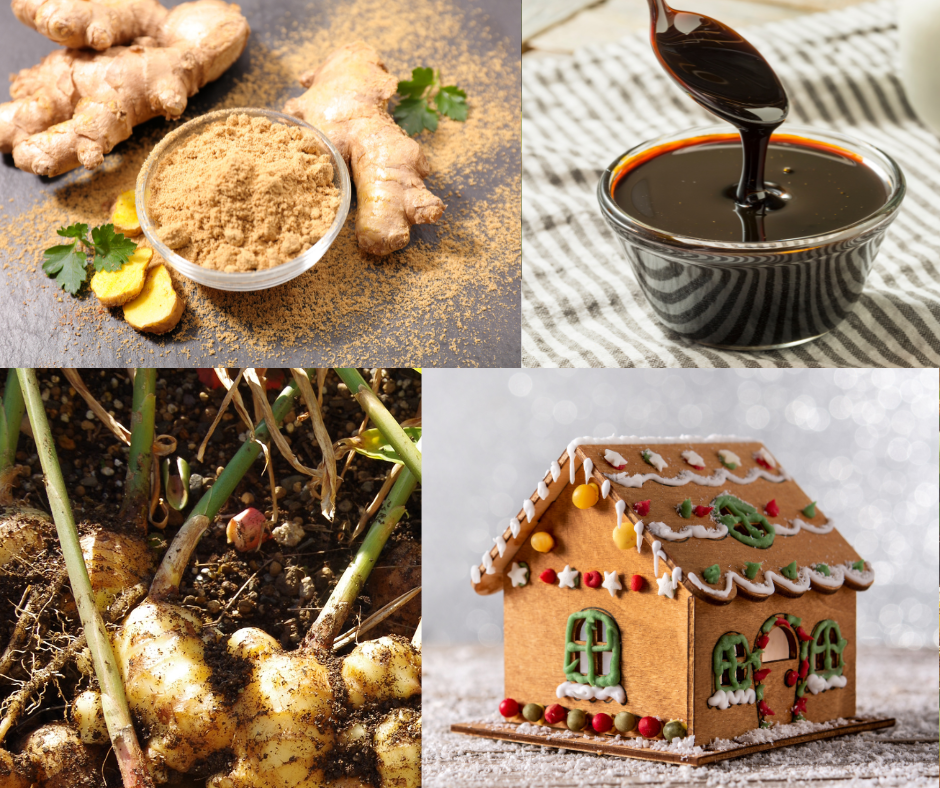Who grew that gingerbread house? The plants of the flavors of the season

The holidays are here, and the sights and smells of the season are everyone. That unmistakable smell of a fresh-cut Christmas tree (or an air freshener that smells the same).
And then there is the kitchen. I am sure you can conjure up fond memories of the holidays just from the smells of vanilla, cinnamon, and the unmistakable classic Christmas spice — ginger. And what self-respecting gingerbread doesn’t have that deep, rich sweet taste of molasses? But what do we know about these to holiday baking essentials?
Ginger is a tropical plant grown for its spicy, unique taste. Ginger is not only a flavorful addition to sweet and savory foods, but it has been known for centuries as an anti-inflammatory.
The part that we eat — whether it is in ground, powdered form in the spice jar, freshly grated or crystallized — we are eating the rhizome part of the plant. Most people think ginger is a root, but in reality, just like peonies and irises, rhizomes are underground stems of plants out of which produce roots and shoots at areas called nodes.
The ginger we eat is botanically known as Zingiber officinale. This is different from the native plant we grow as a groundcover here in Illinois, Wild Ginger Asarum candense. They are not the same, but early settlers did use the roots of wild ginger as a substitute for ginger for some time, as their roots give off a similar fragrance, but wild ginger is not used for culinary purposes today.
You may find it surprising, but you can grow your own ginger, even though it is a tropical plant right here in the Midwest. You just have to treat it like a tender perennial. Tender perennials are plants that could be regular stay-in-the-ground plants IF we had warmer winter temps.
But, because they would be annuals if left out in our freezing winters, we can keep them going if we bring them inside for the cold months.
If you want to try growing ginger, it would be best to buy it from a nursery or plant vendor, but if you don’t want to go to that length, you can try using a ginger root you purchase at the grocery store. But not unlike potatoes, grocery store root crops are usually sprayed with an antisprouting hormone to make them sellable longer, but less likely to sprout if you are trying to grow ginger from the store.
If that is your only option, soak the grocery store ginger in water overnight then discard that water. Do not use it in your plants as it has growth regulators in it. Next, since ginger is a rhizome, you plant it near the surface not buried deep. As usual, you will want to use a medium to large container with a good drainage holes, and potting mix, not potting soil. You can start ginger anytime inside; plant so the rhizome is barely covered and lay it lengthwise in the pot.
Surprisingly, ginger doesn’t need a lot of direct sunlight, only 2 to 5 hours; more than that, and the leaves will yellow. You can set your ginger outside in late May after all those late-spring frosts have passed. Now you wait eight to 10 months to harvest. Be sure to bring your ginger back in before cold weather, no later than late September.
Dig the entire plant — both to save some and replant the rest. Store your fresh ginger in the refrigerator or freezer. If left unpeeled, it can keep for up to 3 weeks in the fridge or 6 months in the freezer.
Molasses is often paired with ginger in recipes. But just what is it? And where does it come from? Molasses is a thick, viscous liquid made from boiling sugarcane or sugar beets. There are three types: light, dark and blackstrap.
The three types are created by varying numbers of boiling. Light molasses is from one boiling, dark is made after two boilings, and blackstrap, also called final molasses is the product after three boilings.
Molasses was first made in the Caribbean, where a great deal of sugarcane or sugar beets were grown and exported around the world. Now it is made in many areas worldwide including the United States.
When you go to buy molasses, you will see it as either sulfureted or unsulfurated. The sulferated variety is made from young sugarcane where sulfur is added as a preservative. The sulfur can leave a bitter aftertaste. Most molasses that we see in the stores is unsulfurated and is produced using mature sugarcane.
And molasses has many health benefits over regular refined sugars. Molasses helps to strength the immune system and helps maintain healthy levels of hemoglobin as well as in creation of new cells.
Molasses has many trace vitamins and minerals and is low-fat. And if that wasn’t enough has a great, deep, one-of-a-kind flavor.
